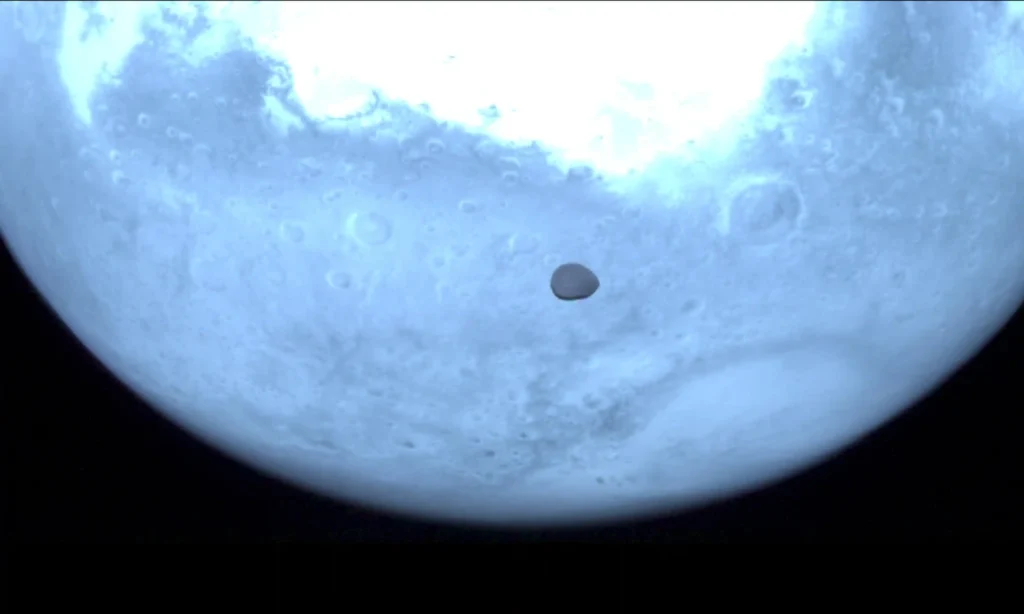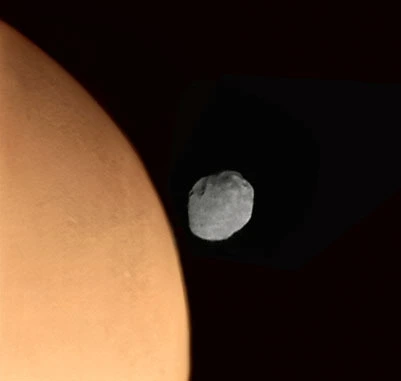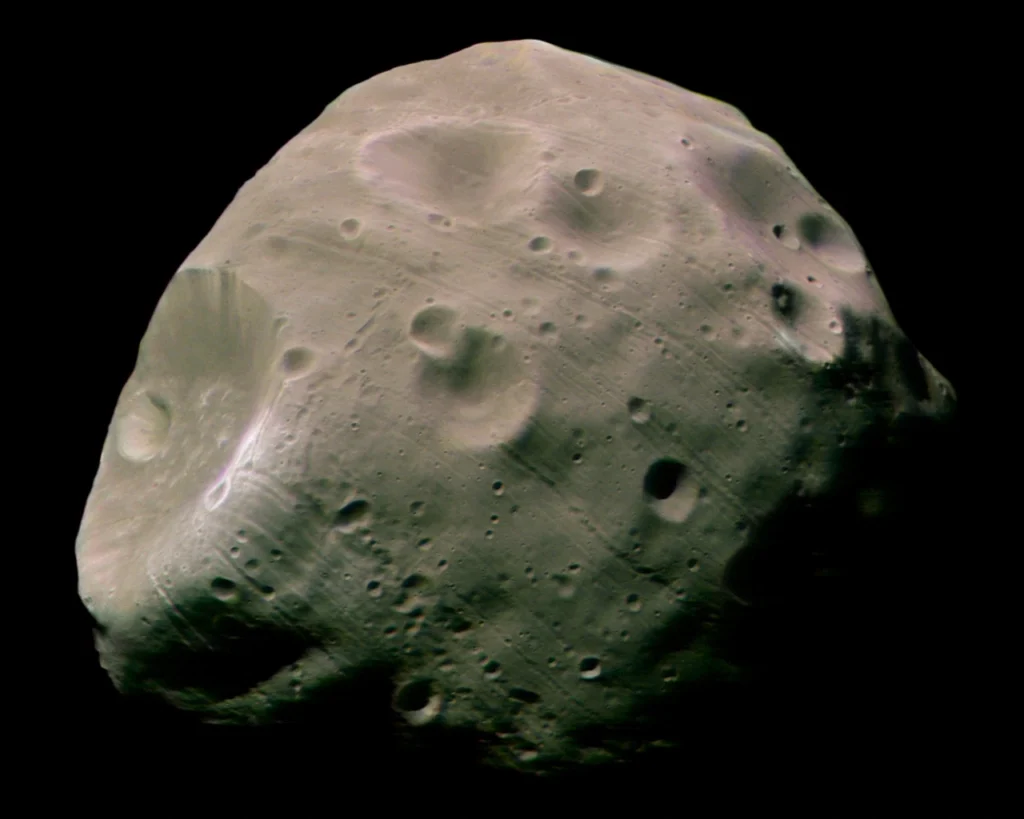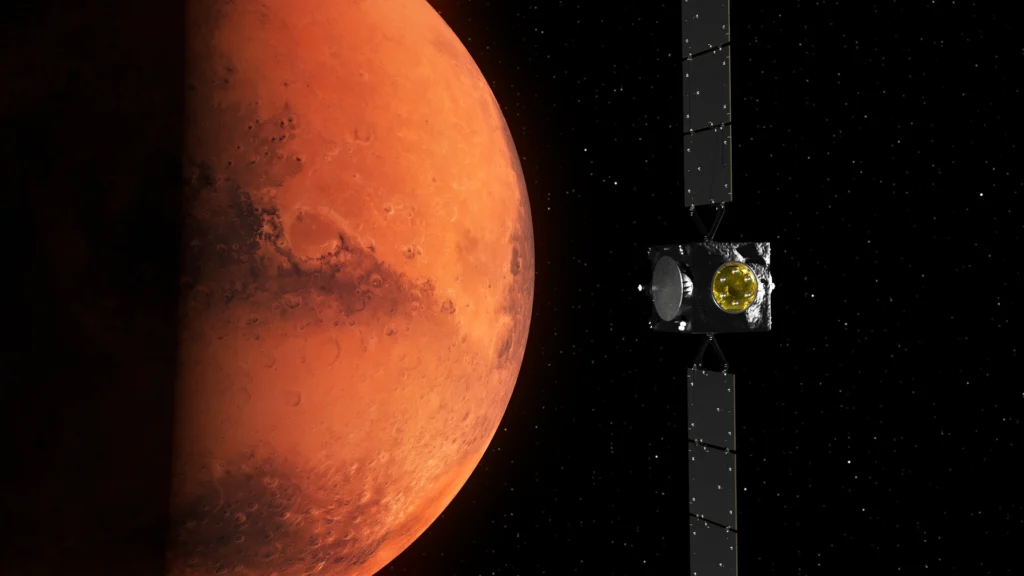The Martian moon Deimos has long intrigued scientists and space enthusiasts alike. Recently, the European Space Agency’s (ESA) Hera spacecraft provided new insights into this enigmatic satellite during its flyby of Mars en route to its primary mission target.

Photograph: European Space Agency
Hera’s Mission and the Mars Flyby
The Hera spacecraft, launched by the European Space Agency (ESA), is on a pioneering mission to study the binary asteroid system Didymos and its moonlet Dimorphos. As part of its journey, Hera executed a gravity-assist maneuver by flying past Mars, a crucial step in adjusting its trajectory toward its final destination. This flyby not only optimized the spacecraft’s path but also provided scientists with a rare opportunity to capture high-resolution images and data of Mars and its lesser-known moon, Deimos. During the flyby, Hera’s advanced instruments were activated to study the Martian system, yielding unprecedented views of Deimos’ surface, shape, and composition. The spacecraft passed at a speed of over 20,000 mph (32,000 km/h), capturing images of Deimos’ dark, cratered body in contrast with the bright, rust-colored terrain of Mars below. This encounter is expected to deepen our understanding of Deimos’ origins and structure while ensuring Hera remains on course for its primary objective—analyzing the aftermath of NASA’s Double Asteroid Redirection Test (DART), which impacted Dimorphos in 2022.

Capturing Deimos: A Closer Look
During its Mars flyby, the Hera spacecraft turned its instruments toward Deimos, one of the Red Planet’s two enigmatic moons. The spacecraft captured high-resolution images of the small, irregularly shaped celestial body from a distance of approximately 620 miles (995 km). Deimos appeared as a dark, cratered object, contrasting sharply against the reddish hues of Mars’ surface in the background. The images provide a rare and detailed view of the moon’s far side, a region that has been studied less frequently than its near side. Scientists hope that the data gathered from Hera’s observations will offer new insights into Deimos’ composition, structure, and origin. One of the most significant questions surrounding Deimos is whether it is a captured asteroid from the outer solar system or a fragment of Mars itself, possibly created by a massive impact. The recent images and measurements from Hera may help resolve this long-standing mystery, shedding light on the evolution of Mars’ moons and their role in the planet’s history.

The Enigma of Deimos
Deimos, the smaller and more distant of Mars’ two moons, has long puzzled scientists with its mysterious origin and unusual characteristics. Unlike Earth’s Moon, which formed from a giant impact, Deimos and its sibling, Phobos, are irregularly shaped and much smaller, resembling asteroids. One prevailing theory suggests that Deimos is a captured asteroid from the outer solar system, drawn into Mars’ orbit by gravitational forces. However, this idea is challenged by the moon’s nearly circular orbit, which is unusually aligned with Mars’ equatorial plane—an alignment that captured asteroids typically lack. An alternative hypothesis proposes that Deimos, along with Phobos, could have originated from a massive collision that ejected debris into orbit around Mars, eventually coalescing into these two moons. Recent close-up images from the Hera spacecraft have provided new data on Deimos’ surface composition, which may help determine whether it shares similarities with Mars or with carbon-rich asteroids. Understanding Deimos’ true nature could offer critical insights into planetary formation and the history of the Martian system, bringing us one step closer to solving the long-standing mystery of Mars’ moons.

Hera’s Primary Mission: Asteroid Investigation
While Hera’s recent Mars flyby provided valuable insights into Deimos, its primary mission focuses on studying the binary asteroid system of Didymos and its moonlet, Dimorphos. This mission is a follow-up to NASA’s Double Asteroid Redirection Test (DART), which successfully impacted Dimorphos in 2022 as part of an experiment to test asteroid deflection techniques for planetary defense. Hera is scheduled to arrive at Didymos in December 2026, where it will conduct an in-depth investigation of the impact site, measuring changes in Dimorphos’ orbit and analyzing the physical properties of both asteroids. Equipped with advanced instruments, Hera will map Dimorphos’ surface in high detail, study its internal structure, and assess the crater left by DART’s kinetic impactor. This data will be crucial for refining future asteroid deflection strategies, ensuring that Earth has a viable defense against potential asteroid threats. Beyond planetary defense, Hera’s mission will also contribute to a deeper understanding of binary asteroids, which make up a significant portion of near-Earth objects. By studying Didymos and Dimorphos up close, scientists hope to gain valuable knowledge about the formation and evolution of these celestial bodies, further advancing our understanding of the solar system.
Table of Contents
Shitsui Hakoishi at 108, was the oldest hairdresser according to Guinness – trendsfocus
Passing probe captures images of mysterious Mars moon | Mars | The Guardian